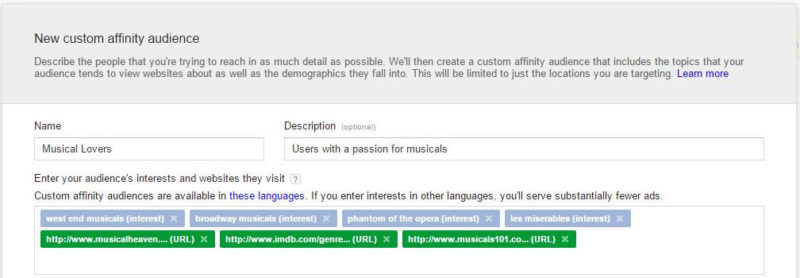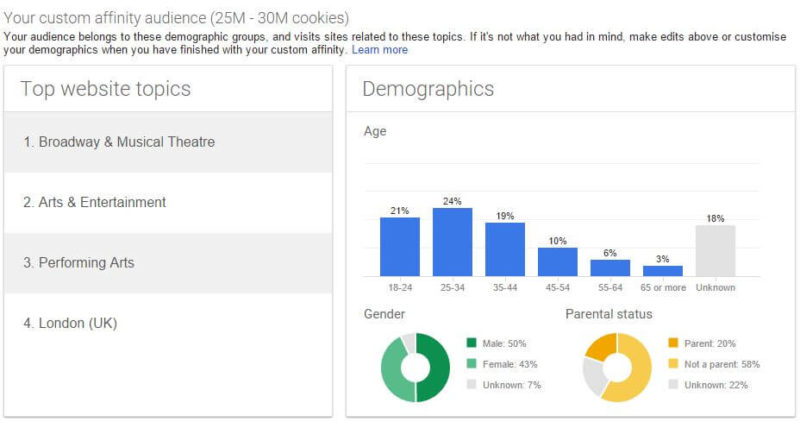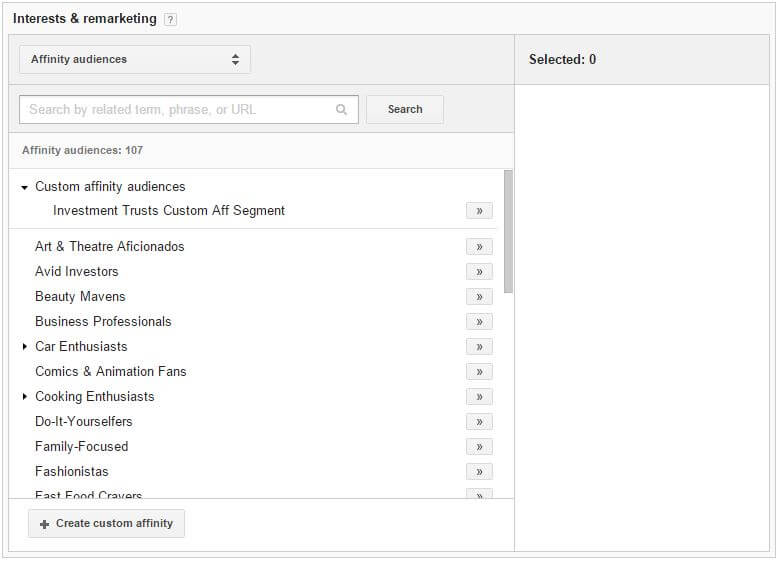Create Your Own Display Audiences With Custom Affinity Segments
Know about Custom Affinity Segments for the Google Display Network? If not, columnist Laura Collins explains why and how to utilize these in your display campaigns.

A key aim for any advertiser using display is, naturally, to serve ads to the most relevant audience possible. Even when bidding on a CPC basis, wasting impressions on users with no interest in your products is pointless. And worse than that, wasting click spend on an irrelevant audience can be damaging to your business.
In October 2014, Google released a new targeting option for the Google Display Network: Custom Affinity Segments. These are Google’s latest offering for advertisers wanting to reach the most relevant audience possible with their display activity.
What Are Custom Affinity Segments?
Custom Affinity Segments are a more tailored version of Affinity Audiences, an established targeting option on the Google Display Network which allows you to reach predefined audiences that could be receptive to your ad messaging.
With Affinity Audiences, if you’re looking to target people with a passion for food, you could use the Foodies audience. If it’s people who love big cars, then Truck & SUV Enthusiasts could be for you. In fact, there are dozens of options to choose from, suitable for a wide range of verticals.
Unfortunately, most of these audiences are fairly broad. Furthermore, they are predefined by Google — and while there’s a great selection, they don’t cover every base. If you’re trying to promote a niche product, you might not be able to find the right Affinity Audience for your purpose. This is where Custom Affinity Segments come in.
Let’s imagine you own a ticketing website and are promoting a new musical. Previously, your best option within Affinity Audiences would have been Art & Theatre Aficionados. As you can imagine, this is a very broad category that could target anyone from Shakespeare enthusiasts to Pop Art lovers, none of whom are guaranteed to enjoy a musical.
Instead, you can now use Custom Affinity Segments to create a bespoke audience of lovers of musicals, even down to a particular genre. Below is an example of the kind of segment you could put together to target this niche audience, using a combination of interests (based on keywords) and websites that apply to your users.
Google determines the theme of your segment by interpreting the keywords and URLs provided. It also allows you to preview the website topics it has deemed relevant and the user demographics present within your segment, using the preview tool. This preview lets you gauge how accurate Google’s interpretation of your interests and websites has been; in the case below, we can see from the suggested website topics that it’s done pretty well.
Another example could be a health foods retailer. The Foodie category within Affinity Audiences could put your ad in front of people with a passion for exactly the wrong types of food. But by using a custom segment composed of health food websites and keywords like “super foods” and “organic produce,” you’re getting much more granular with your targeting.
Or consider a retailer promoting shirts for a particular football team; instead of using the Football Fans audience, which is quite broad, you can create your own to ensure your ads are being served to the right fans.
How To Create Them
Setting up your own Custom Affinity Segments is so simple that anyone can give it a try. Simply create a new ad group within an existing or new display campaign, and within the “Interests & Remarketing” targeting option, select Affinity Audiences. Below the standard list is the option to create your own custom segment. Then, all you need to do is start adding keywords and URLs to find that perfect audience!
Results
Here at Periscopix, a Merkle Company, we’ve been trialing Custom Affinity Segments across a range of clients and have seen some promising results.
A large financial services client wanted to target users with an interest in financial markets, likely to invest their own money. With this in mind, we created a segment using a combination of keywords (e.g., investment trusts, investing money) and websites (e.g., Morningstar and This Is Money). After an initial optimization period of four weeks, the Custom Affinity Segment was soon achieving a CPA only 63% higher than remarketing activity, and actually 34% lower than that of programmatic display activity.
It’s also worth noting that in addition to bringing in conversions within CPA target, the custom segment became a bigger driver of impressions and clicks than all search and remarketing activity combined.
Are They Right For Me?
The bespoke nature of these segments means they can be created for almost any product or vertical, while the easy setup means they’re an option most advertisers could add to their display targeting repertoire. They offer an extra layer of granularity which is particularly useful for more niche products, but a reach that can appeal to even the largest advertiser.
As with any new product, it’s worth testing the waters on a smaller area with low bids and budgets. From there, you can establish efficiency and look to expand your Custom Segments collection if you see success.
Final Thoughts
As advertisers fight the battle against “banner blindness,” getting your ads in front of the right user is more important than ever. Custom Affinity Segments leave you less reliant on Google’s predefined targeting options and more able to create your own tailored audiences. If you’re already running display activity, I’d recommend testing these out and seeing how they compare.
Contributing authors are invited to create content for Search Engine Land and are chosen for their expertise and contribution to the search community. Our contributors work under the oversight of the editorial staff and contributions are checked for quality and relevance to our readers. The opinions they express are their own.
Related stories



